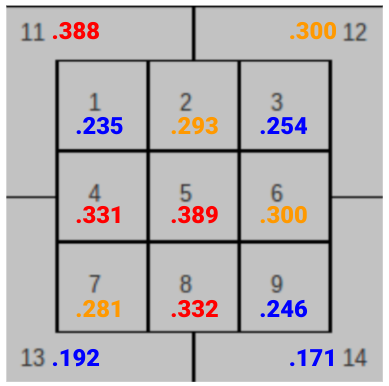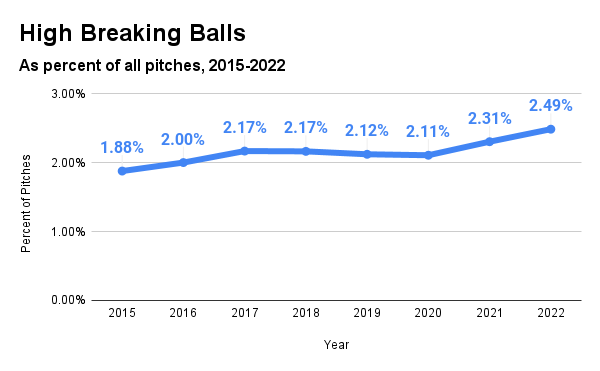One of the overarching takeaways of the sabermetric era of professional baseball is that the nerds have used data analysis to chip away at a century-plus of widely (and often firmly) held baseball beliefs and truisms that turned out not to stand up to objective scrutiny. Sacrifice bunts. Pitching to contact. Productive outs. Intentional walks. Long starting pitcher outings. The list goes on.
It’s not a secret that the majority of the strategic innovations brought about by the wealth of data at teams’ fingertips have benefited the run prevention side more than the run creation side. Pitchers have ruthlessly optimized their arsenals and adopted strategies that target opposing hitters’ weaknesses at increasingly granular levels.
Those ever-more-pinpointed attacks have steadily come into favor at the expense of some long-held pitching principles, like the importance of pitchers establishing their fastballs (despite higher-than-ever-before velocity) and the idea that pitchers should primarily work those fastballs down in the zone to coax weak, early-count on-the-ground contact. These historic pitching foundations have been broadly shunned in favor of chasing the swings and misses that are available from fastballs at the top of the zone and using traditionally secondary pitches as primary offerings.
Now, another of this kind of conventional wisdom – pitchers locating their breaking balls exclusively low – is being challenged.
Break ’em High
Traditionally, it’s been thought to be true that curveballs and sliders needed to be thrown low for maximum effect. Hangers up over the plate get hit hard and swing and miss chases are most often available down below the zone. While that still tends to be true, pitchers have been finding that they can also get positive results by targeting the top of the zone with their breaking pitches.
Our Ben Palmer wrote about the success of high breaking balls two offseasons ago and presented some convincing data about the effectiveness of high breakers, especially in terms of getting called strikes. Below is an updated version of Ben’s findings, covering the 2015 season (when Statcast was fully implemented) through games played this past Sunday:
Fifty-three percent called strikes and whiffs? That’s incredible. Pick your favorite most dominant individual pitch and they don’t come close to getting that rate of called strikes and whiffs. Corbin Burnes’ cutter? 35% CSW%. Jacob deGrom’s slider? 45% (last season). Gerrit Cole’s fastball? 37%. You get the point. Yet, the entire league, when throwing breaking balls up in the strike zone the past seven seasons has gotten the best kinds of outcomes for pitchers better than half the time. If you add in foul balls, which often just go as strikes against the batter, that jumps up to 73%.
What’s more, high breaking balls in the strike zone have actually outperformed low breaking balls in the strike zone over the same period. Take a look at this graphic is showing the weighted on-base average (wOBA) allowed by breaking pitches in each gameday zone:
 Data from Statcast
Data from Statcast
Of course, the conventional wisdom of throwing breaking pitches low in and out of the zone is backed up by this results data. Those are still the most effective spots for breaking balls and the primary reason that about 65% of all breaking pitches are thrown in those bottom five gameday zones.
But, if you are a pitcher throwing those breakers inside the strike zone, there are good reasons to aim high. Across gameday zones 1, 2, and 3, breaking balls have allowed a cumulative .265 wOBA since 2015. Across zones 7, 8, and 9, they have allowed .289 wOBA, in aggregate.
I don’t know about you, but that’s not what I expected.
Given that data, it’s probably not surprising to see that the share of pitches that are high breaking balls has been growing ever so slightly in recent seasons:

Data from Statcast
Now, it’s worth calling out that the overall share of pitches that are breaking balls has also been steadily increasing in recent seasons, so some of the increasing trend in the plot above is simply a byproduct of pitchers throwing more breaking pitches.
A quick Statcast search confirms that the share of breaking pitches that have been located at the top of the strike zone has held steady between seven and eight percent since 2015. Nonetheless, the takeaway is the same – of all the pitches being thrown, more of them are breaking balls that are up.
The strike zone heatmap graphic shown above also illustrates another important point that Ben touched on in his article. Targeting the upper parts of the strike zone with breaking stuff is a risk and reward proposition. If you miss your spot when targeting the top of the zone with breaking pitches, which tend to break downward, the break might land that pitch right across the nitro zone middle where the red numbers live. The numbers make it obvious that a pitcher needs to have very strong breaking ball command (and some nerve) to go against the grain and try to drop a curveball or sweep a slider in up high. But, if you can do it, there are advantages to be had.
Spinning with Confidence
The 2022 season data shows that some of baseball’s best spin artists might think the risk is worth the reward. Here’s a sampling of notable names that show up near the top of the list of pitchers that most often throw high breaking balls:
Sure, I cherry-picked from the overall list of pitchers a little bit, but all of these pitchers rank in the top 75 for the percentage of high breaking balls thrown this season. These are some of the best arms in all of baseball who, unsurprisingly, are widely known for their ability to spin the baseball whether it be for curveballs (Hill, Fried, Urías), sliders (Wisler, Archer, Márquez, Ohtani), or both (Kershaw, Verlander, Bieber, McClanahan). If you were just intuitively selecting a group of pitchers that would be good candidates to attempt this high breaking ball strategy, these are the names you would probably pick.
https://gfycat.com/sombertinyjunco
Of course, it’s undoubtedly true that some of these pitches were not intended to be thrown in high locations. Some of them are missed spots. But a lot of them were intended to be up. How the catcher sets a target gives that away. It’s also true that high breaking pitches are not a huge fraction of pitches thrown. There is no risk of them becoming a primary feature of any pitcher’s approach. But, the data and video illustrate the subtle shift in approach pitchers have been making as the game has become more and more spin-heavy. Pitchers (especially the really good ones) are not concerned with being extra fine with their breaking stuff and putting it only in locations where the margin for error is great. They are being aggressive and throwing it for strikes, all around the strike zone.
The results speak for themselves. Yes, it’s still early in the season and we are dealing with a small sample size here – most of these guys have not even thrown 30 high breaking balls yet this season. But, the data is clear that high breaking balls are becoming slightly less taboo. For pitchers with the skills to take advantage, they are a new viable and effective weapon.
Photos by: Leslie Plaza Johnson/Icon Sportswire, Samuel Stringer/Icon Sportswire, Frank Jansky/Icon Sportswire | Adapted by Matt Fletcher (@little.gnt on Instagram)


“Of course, it’s undoubtedly true that some of these pitches were not intended to be thrown in high locations. Some of them are missed spots. But a lot of them were intended to be up. How the catcher sets a target gives that away. ”
This isn’t true. Catcher set up “high”, both because they may want the target up, but also because they want to be in a more athletic position to receive the pitch (common with off-speed pitches with 2 strikes and/or a stolen base threat on base). Not a single one of the pitches in the clip montage supports the idea that the catcher is calling for a high breaking ball with signficant vertical break (e.g. a curveball; the sliders are more important as either in on the hands or on the backdoor). As an example, look at the 1st pitch from Cease. It’s a 1-2 count, and the catcher specifically asks for it in the dirt, even though his stance is high and athletic. This is in preparation for a pitch that’s potentially in the dirt, rather than asking for high middle curveball on a 1-2 count. In the other pitches in the clip, the catcher specifically asks for it low, is down low on a knee looking to get a called strike (note: this is moreso for the low, one or both legs splayed out version than higher version that guys like Gary Sanchez and Mitch Garver use all the time), is expecting a low curve with 2-strikes, or is throwing a slider.
I believe the trend numbers, though I’d need much more evidence to believe that pitchers are intentionally throwing with high intended locations (with the caveat that FB usage is down and pitchers increasingly look to throw breaking balls as strikes). I think the high curveball locations are more a result of increased off-speed usage league-wide- and an increased emphasis earlier in counts- than it is an indication that pitchers are intentionally throwing curveballs up. Sliders have enough variation in movement, that I would accept the hypothesis that more of them are being thrown up in the zone, with the addendums that cutter/slider classification is very imprecise and less vertical sliders are being used in a way more traditionally approached with cutters (e.g. hard and in on a opposite-handed batter’s hands).
The top 4 names on the high breaking ball frequency leaderboard have all played for the Twins recently, and I don’t think this is a coincidence, since the Twins are known to value good sliders in their free agent targets, and to push their pitchers to throw more high sliders.